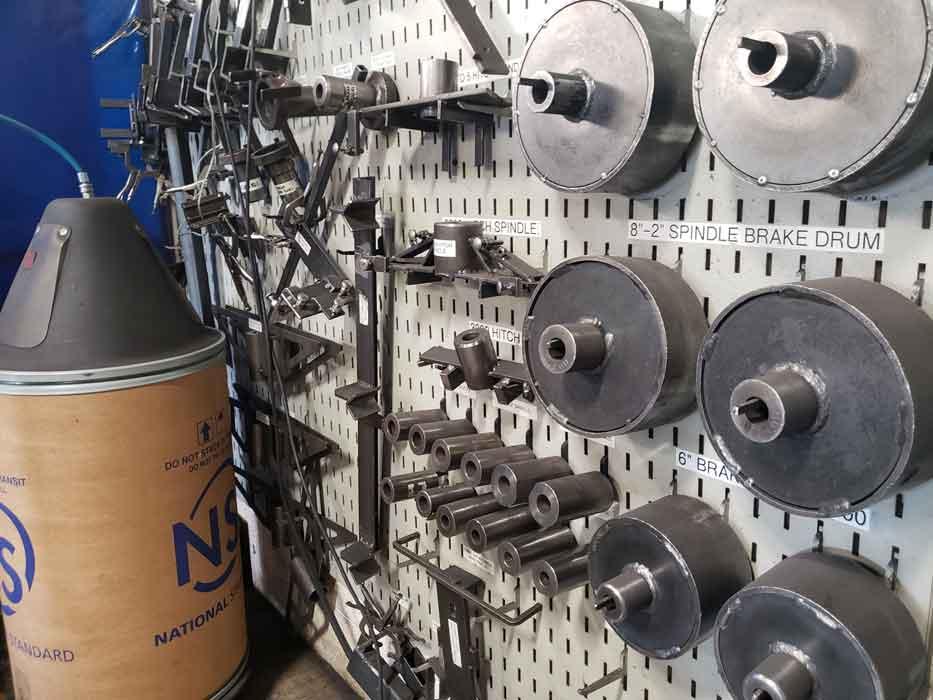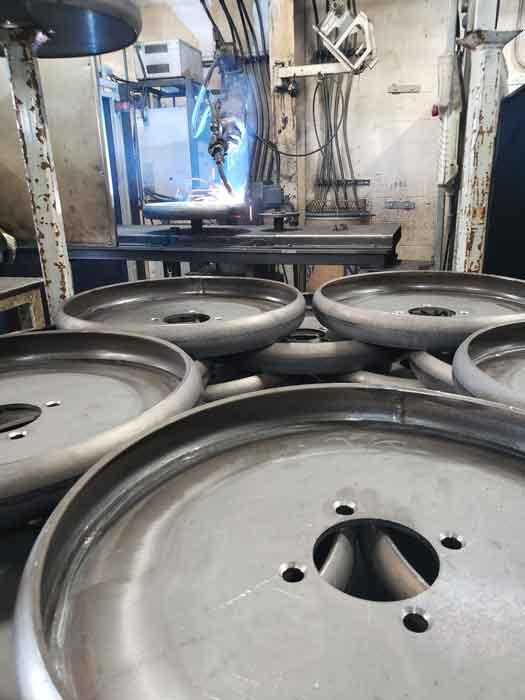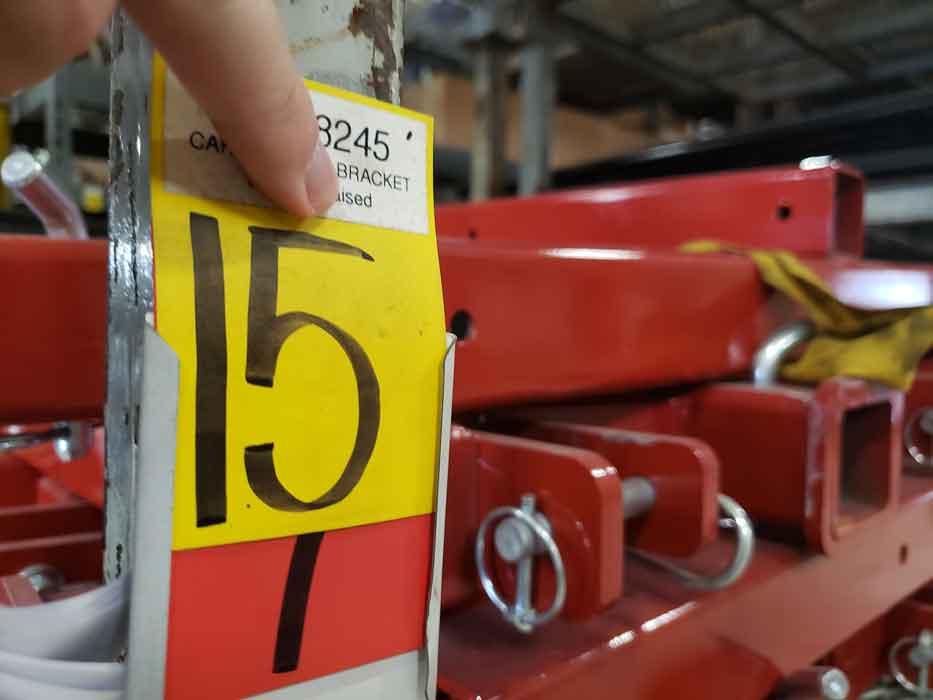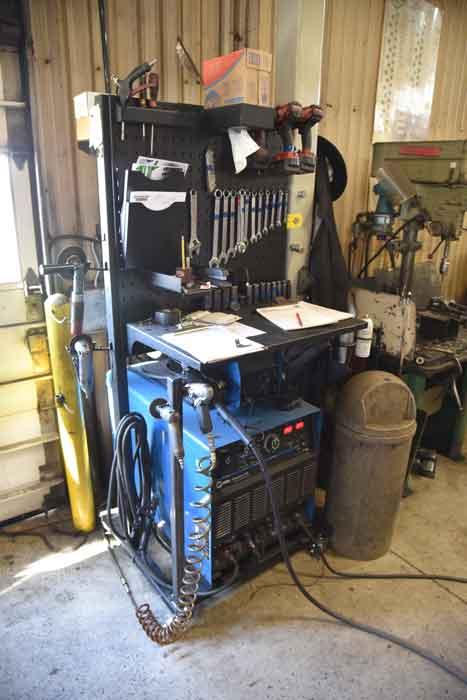Senior Editor
- FMA
- The Fabricator
- FABTECH
- Canadian Metalworking
Categories
- Additive Manufacturing
- Aluminum Welding
- Arc Welding
- Assembly and Joining
- Automation and Robotics
- Bending and Forming
- Consumables
- Cutting and Weld Prep
- Electric Vehicles
- En Español
- Finishing
- Hydroforming
- Laser Cutting
- Laser Welding
- Machining
- Manufacturing Software
- Materials Handling
- Metals/Materials
- Oxyfuel Cutting
- Plasma Cutting
- Power Tools
- Punching and Other Holemaking
- Roll Forming
- Safety
- Sawing
- Shearing
- Shop Management
- Testing and Measuring
- Tube and Pipe Fabrication
- Tube and Pipe Production
- Waterjet Cutting
Industry Directory
Webcasts
Podcasts
FAB 40
Advertise
Subscribe
Account Login
Search
Amish manufacturer embraces lean manufacturing
The plain community turns to continuous improvement in manufacturing and fabricating processes
- By Tim Heston
- November 9, 2019
- Article
- Shop Management

Pioneer Equipment started its lean journey in 2008, just in time to meet the demands of a changing market.
Standing by an open door by Pioneer Equipment’s fab shop floor, adjacent to a gravel lot outside, I shook hands and exchanged pleasantries as the company’s 40 employees left for the day. I was glad to meet them, especially considering what company managers had told me.
“When it comes to having trouble finding skilled people, on a scale of 1 to 10, with 10 being the worst, the outside world is at a 10. It’s dire right now. It’s what keeps people up at night. But not here. I’d say we’re about a 2.”
That was Steven Wengerd, director of sales, and just after he spoke, I glanced outside. I heard no cars, saw no traffic leaving the white gravel parking lot where my rental car sat alone. Everyone walked or rode bicycles, a quiet departure in the late afternoon October sun. Such is rush hour in the plain community amid rolling farmland outside Dalton, Ohio.
They left the shop floor highly organized, with a mature 5S program full of labeled, modular workstations—designs they’ve trademarked, patented, and are selling to others through the company’s Pioneer Industrial Workflow Solutions (IWS) subsidiary. Fixtures are labeled and stored logically and clearly, job routing paperwork is clear and intuitive. Even a novice on his first day could find his way around.
The place even has a few single-piece-flow cells dedicated to repeating jobs, complete with welding robots and pneumatic quick-change fixtures. Cross training abounds. The company has several OTC Daihen robot welding cells, a Mazak laser with load/unload automation, a new Bystronic press brake, and has invested in off-line bend programming and simulation along with SolidWorks.
The company works with outside banks and accounting firms, of course. On occasion it collaborates with outside engineers. And it recently hired a marketing professional who isn’t Amish. But like everyone else in the plain community, not one Amish worker at Pioneer attended school beyond eighth grade. Many started working when they were just 13, helping and learning the ways of the shop before working with large equipment at 18. As managers explained, Amish education doesn’t stop when they’re hired. In many ways the education never stops.
Eddie Wengerd, general manager (and Steven’s older brother), said it best: “Instead of learning a trade, as a culture, we learn how to learn. Instead of just learning to weld, I can learn how to learn how to weld, or to be an IT person, or a shipping manager. I’ve learned how to learn. Then the door swings wide open.”
The Technology Line
Pioneer defies the Amish stereotype of a simple life separated from the outside world and modern technology. Reality is more nuanced.
“There are many different groups in the plain community,” Eddie said. “Every group draws a line [regarding technology use], and it’s decided by the group, not by the individual.”
“We look at technology in a unique way,” Steven said. “We always ask, ‘How can we use parts of it?’ There are elements of technology we use as tools, but we don’t fully embrace them.”

This grid panel, part of a cell dedicated to buggy undercarriages, was where the idea for Industrial Workflow Solutions was born.
The factory operates off the electric grid. A 400-HP natural gas generator near the back of the shop powers everything from the lights and computers to robot welding automation. The compact front office has sit-standing desks, air conditioning, and desktop computers for accounting and plant scheduling. The company has a phone land line and a few flip phones shared by the sales team and others who travel for business.
A Unique Ag Market
Although the technology line varies, for most Amish certain attributes of life are likely to stay the way they have been for generations. For example, tractors aren’t unknown entities among the plain people, but horse-drawn agriculture still dominates, and that’s not likely to change anytime soon.
The market really wasn’t viable for small fabricators until surprisingly late into the 20th century, thanks largely to manufacturing giants like Deere & Co. “In the early part of the last century, Deere made a million walking plows in a year’s time,” Steven said. “But as the Industrial Revolution took hold, people left horse-drawn agriculture.”
As more farmers adopted tractors, they sold their horse-drawn equipment to the used equipment market. Deere and others couldn’t sell their existing inventory either. So over the decades, truckload after truckload of walking plows and sulky plows (which have a seat for riding) made their way to the Amish communities in Ohio, Pennsylvania, and elsewhere. “They were everywhere,” Steven said, “and they were available for pennies on the dollar.”
By the 1970s, though, the horse-drawn systems were rusting beyond repair, and new equipment just wasn’t available. Amish made do, often turning to local blacksmiths or fabricating their own plows if they could, but it certainly wasn’t ideal.
In the mid-1970s, an industrious Amish farmer and his father attached a beam to a Raydex “easy pulling” plow bottom. They tested a new walking plow design, running it behind a hill, away from prying eyes. It was Henry Wengerd and his son Wayne, grandfather and father, respectively, of the eight Wengerds (seven brothers and one sister) who work at Pioneer today.
“They didn’t want to make a big show of it,” said Daniel Wengerd, Wayne’s oldest son and today Pioneer’s president and CEO. “They went behind the hill near the farm, which is just a mile south of where the shop is now, and made the first couple of rounds—and, lo and behold, it worked. It needed refining, but it was enough to build a prototype, and it continued from there.”
Too Much WIP
Even though Pioneer produces niche products for a unique corner of the ag market, its evolution is anything but unique. The company began as a relatively low-mix product line manufacturer of horse-drawn farm equipment. Its service center plasma-cut plate components and delivered blanks, which made their way through the shop in large batches. Most forming occurred on several Piranha ironworkers, and if the operator couldn’t find a tool to form a particular part, he worked with the shop machinist to create the tool he needed.
Work-in-process was everywhere. It took weeks or months for new workers to learn how to find tools they needed quickly. Healthy margins were there, but overall, inventory levels were high and inventory turns were extremely low.
Pioneer’s outside accountant pointed this out in 2008 and suggested that the Wengerds consider a new strategy: lean manufacturing. The brothers were unsure but decided to reach out to a lean consultant—and Six Sigma black belt—associated with the accounting firm.
They conceded that it wasn’t an easy step. After all, the consultant came from outside the ag industry, didn’t know the first thing about farming, and here they were hiring him to review their processes. Moreover, would the lean consultant preach the virtues of the Toyota Production System and force-feed the methodology into their high-product-mix operation?
Pioneer managers knew the company was making good money. When the bottom line’s healthy, why change a good thing? The shop seemed incredibly busy, and the business was growing so quickly that they were running out of space.
But they ultimately made the leap. The consultant toured the shop but didn’t simply start barking orders about what was right and wrong. He listened, learned shop practices and its culture. Then he suggested everyone in the organization take a crash course in 5S, shut down the plant for a day, and give everyone time to improve their workstations.
Hearing this, the brothers were taken aback. “We thought we were doing well,” recalled Leon Wengerd, second from the oldest brother and Pioneer’s CFO. “It was almost an insult to us.”
But they came to consensus and invited the consultant in for a morning to teach the basics of 5S. Everyone returned to their stations and—to the brothers’ amazement—began changing things immediately. People discarded any tool they hadn’t used for eight weeks, and before long they created an enormous pile in the middle of the shop. “We ended up selling more than $10,000 of stuff that our people just didn’t need anymore,” Daniel said
Steven recalled one drill press operator who returned to his station, took a piece of half-round bar stock, and drilled holes in it—creating a simple tree for holding the drill bits, custom built for just what he needed.
Eddie nodded in agreement. “People started doing things that we just never would have thought of.”
Leon chimed in. “And I know we said we made $10,000 on all the equipment we didn’t need, but we spent much more than we saved. We knew we needed to give people the right tools they needed to succeed. If we as leaders didn’t support them, the whole effort would have failed.”
This included spending a few dollars on new wrench sets and other hand tools to ensure each station had just the right number of tools it needed. Determining that number is key, because 5S falls apart quickly if someone spends too much time hunting for tools that aren’t at his workstation.
The “right tools” also includes some of the shop’s biggest capital expenditures, like the Mazak laser and Bystronic press brake. “The price tag for this equipment can be scary,” Leon said, “but if we look at the long term and the time savings, we can stay ahead because of that investment. But it has to be the right machine for our processes.”

A robot lays a circumferential weld around the inside diameter of the landside wheels of sulky and rock plows.
Not one of the brothers mentioned cutting inches per minute or formed parts per hour. They instead described how the machines fit into process flow, which has evolved into a mix-mode model incorporating make-to-stock pull systems as well as make-to-order production.
Before becoming lean, the shop used to spot-buy raw stock every month. Post-lean implementation, the company works with its suppliers on quarterly commitments and small, partial-truckload deliveries every other day—enough to fill a pallet on the laser’s automated load/unload system that runs all day and unattended at night.
Planners receive orders from multiple sources, including custom orders as well as orders triggered by a kanban replenish system in finished goods inventory. The laser is programmed two days out using dynamic nesting exclusively. Those parts then are transported to the fab shop, where they’re staged at initial fabrication and welding stations. Some stations are dedicated to custom and make-to-order work, while others are dedicated to specific repeating parts.
Outside the high-product-mix work, the company has two multiprocess cells. One is dedicated to wheel production, a make-to-stock item used on various horse-drawn ag equipment models. Blanks with short flanges (formed on the new press brake) are fed into a roller, welded, ground, cleaned, assembled, and painted. Another cell produces a make-to-order undercarriage, sold under the Pioneer Carriage brand, that’s assembled and sent to buggy-makers nearby and in other plain communities.
Pioneer in 2019 looks nothing like it did in 2008. Not only does it have 50 percent less WIP and 25 percent less finished goods inventory, it makes a wider range of products.
“For us, our lean journey happened at just the right time,” Eddie said, adding that the increased efficiency has allowed the company to invest more in research and product development. “I really don’t know where we would be without lean manufacturing.”
Work Flow Through Modularity
Amish culture fosters unique needs that the wider market doesn’t fulfill, so they build what they can’t buy. This kept Amish farms going as horse-drawn equipment manufacturing on a large scale essentially disappeared after the 1950s. Farmers first repaired or built what they needed and perhaps visited a blacksmith for some advanced work.
As the brothers found, that “just build it” character also helped Pioneer’s lean initiative. A prime example hangs above the assembly bay: an overhead bridge crane that has a maximum capacity of just 850 pounds.
“When you need to move it, you just do this,” Steven said, grabbing a rope and moving the bridge crane manually across the shop. Assemblers need not operate fancy hydraulics or wait for a bridge crane operator to maneuver a device that has far more lifting power than they’ll ever need. Employees just reach up and pull.
Steven smiled. “See? Simple.”

This kanban replenishment space holds a maximum of 15 components; reaching seven (designated by the red card) triggers an order for more.
That “build it” character trait played a key role in sustaining the company’s 5S efforts. Pioneer faces similar challenges as custom fabricators and other job shops in that needs change over time. For a few weeks or months, a workstation might need a certain set of tools, but as the product mix changes, so does the tool mix.
At first Pioneer employees fabricated carts to suit their needs. Then several weeks or months later their needs changed, and they built a new cart. It worked at first, but it wasn’t very sustainable, especially as product lines diversified.
Then one day, within the newly created cell dedicated to undercarriages, one employee designed a sheet metal panel with slots where different shelves, rods, and hooks could attach. This created a modular workbench that—with no tools at all—could be assembled, reassembled, and relabeled over and over as needed.
During the shop tour, Eddie paused and pointed at the slotted panel, today holding all the parts and tools needed for the current undercarriage product mix. “This is where Industrial Workflow Solutions was born.”
For several years employees built various iterations of the modular cart, always on wheels so it could be maneuvered where needed, but always designed with modularity in mind. As Eddie recalled, “Eventually our lean consultant saw this and asked, ‘Why don’t you sell this?’” Not only would other job shops and high-product-mix manufacturers find use for these modular carts, but so would other sectors. Retailers, for instance, could use them as flexible point-of-purchase displays.
“At first we just didn’t have the time,” Eddie said. “But then, when we installed our laser and new press brake, we took our productivity to a new level.”
This, he said, gave the company the resources it needed to launch Pioneer IWS.
Employees started using double-sided wheeled carts, one side with all the tools necessary, the other side with the job traveler paperwork and quality documentation. Other carts had dedicated tool sets in various areas. If the product model changed, the worker simply turned the cart around and grabbed from the new tool set.
The company now produces an IWS catalog showing different work center configurations, all touting the slotted panel, now branded as the Gridlok™ system. Since its launch in 2016, the product line has gone through several iterations, and development continues. In early October the company was prototyping a flexible weld table concept with fixturing pins that could be placed on the table itself, then stored neatly to a Gridlok panel on the table’s sides.
Learning to Learn
The Wengerds don’t hide the fact that Pioneer’s history stands apart from most fabricators’. The company hand-drew its prints until 2011, when it leapt past 2D CAD right into the latest 3D CAD system from SolidWorks. In 2008 office personnel used manual typewriters and didn’t get their first computer until 2011.

Old ways meet new technology. This rock plow, fabricated by Pioneer, incorporates laser cut parts formed on CNC press brakes as well as robotically welded wheels.
“We had to learn how to use a mouse,” Daniel chuckled.
During an office tour, though, Eddie showed just how far Pioneer had come in such a short time. The company is weighing its options when it comes to enterprise resource planning, but for now the Excel sheet, tied directly into Pioneer’s accounting software, works smoothly.
The company’s IT director, all of 18, also defies stereotypes that all Amish (and anyone else who grows up on the farm, for that matter) are somehow wired to build things and work with their hands. “He tried his hand at welding, and that didn’t work out too well,” Daniel recalled.
Eddie added that the IT operation does have an outside adviser, but by and large, the shop’s own IT guru—again, someone who didn’t go to technical school, college, or anywhere else beyond eighth grade—has delved deep into writing computer code and developing the server architecture that meets the unique needs of an Amish fab shop.Eddie paused, then went back to his point on how people in the Amish community learn. “Learning by doing” isn’t quite on the nose. Diving quixotically into a project, making the same mistakes over and over, isn’t learning by doing. Doing that would neither raise a barn in a day nor grow sales at a rural Ohio fabricator by 15 to 20 percent in the past few years. “Learning to learn” is much more apt.
How does one learn to learn, exactly? Reading helps, of course. Part of my interview with the brothers occurred in a large meeting room with one wall lined completely with books, from floor to ceiling, with titles covering anabaptist history and the history of farming equipment.
As the brothers explained, growing up in a community also helps, where the group stands above the individual. People learn to listen—really listen. When they join a company like Pioneer, they learn from their co-workers as well as their suppliers and customers.
“That’s been a huge theme for us,” Steven said. “When we meet with our vendors, we want to learn about their business model, and we want them to know about ours. We then ask, ‘How can the two blend together?’”
The people at Pioneer also don’t hesitate to collaborate with customers and vendors within and outside the plain community. For instance, they collaborated with engineers at a large combine spring-tine manufacturer to design the tine springs on the company’s horse-drawn tine-weeder designed for organic farming, which has become more popular as small farmers compete with big agribusiness.
“We had an engineer who helped us design a tine that had the right amount of spring for a horse-drawn application,” Steven said. “By buying the very latest technology and combining it with content from way back when, we can make a machine that puts the horse farmer at a very competitive edge in today’s market.”
Eddie pointed to a prototype on the floor with a beam component on a horse-drawn plow. Pioneer called an engineer at a Norwegian plow manufacturer, built a relationship, and eventually flew him over to Ohio. “He helped us design this unit. And now we’re using their beam kit from across the pond. Rather than reinventing the wheel, we’re very big on partnerships and collaborations.”
Both in continuous improvement and in the plain community overall, one listens, thinks of the group first, and learns to learn.
Considering all this, it’s little wonder Pioneer’s CPA thought lean manufacturing would be a good fit.
About the Author

Tim Heston
2135 Point Blvd
Elgin, IL 60123
815-381-1314
Tim Heston, The Fabricator's senior editor, has covered the metal fabrication industry since 1998, starting his career at the American Welding Society's Welding Journal. Since then he has covered the full range of metal fabrication processes, from stamping, bending, and cutting to grinding and polishing. He joined The Fabricator's staff in October 2007.
subscribe now

The Fabricator is North America's leading magazine for the metal forming and fabricating industry. The magazine delivers the news, technical articles, and case histories that enable fabricators to do their jobs more efficiently. The Fabricator has served the industry since 1970.
start your free subscription- Stay connected from anywhere

Easily access valuable industry resources now with full access to the digital edition of The Fabricator.

Easily access valuable industry resources now with full access to the digital edition of The Welder.

Easily access valuable industry resources now with full access to the digital edition of The Tube and Pipe Journal.
- Podcasting
- Podcast:
- The Fabricator Podcast
- Published:
- 04/16/2024
- Running Time:
- 63:29
In this episode of The Fabricator Podcast, Caleb Chamberlain, co-founder and CEO of OSH Cut, discusses his company’s...
- Trending Articles
AI, machine learning, and the future of metal fabrication

Employee ownership: The best way to ensure engagement

Steel industry reacts to Nucor’s new weekly published HRC price

How to set a press brake backgauge manually

Capturing, recording equipment inspection data for FMEA

- Industry Events
16th Annual Safety Conference
- April 30 - May 1, 2024
- Elgin,
Pipe and Tube Conference
- May 21 - 22, 2024
- Omaha, NE
World-Class Roll Forming Workshop
- June 5 - 6, 2024
- Louisville, KY
Advanced Laser Application Workshop
- June 25 - 27, 2024
- Novi, MI



























